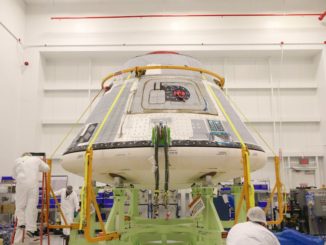Video credit: ISRO
India’s space agency tested a launch escape system Thursday that could be used on a future spaceship designed to carry astronauts into orbit.
The abort rocket lifted a prototype crew capsule off a launch pad at Satish Dhawan Space Center, a launch base on India’s east coast, to an altitude of nearly 9,000 feet, or 2.7 kilometers, according to a statement released by the Indian Space Research Organization.
Seven solid-fueled rocket motors pushed the unoccupied 13.9-ton (12.6-metric ton) test vehicle off its launch pedestal at 0130 GMT Thursday (9:30 p.m. EDT Wednesday). The prototype crew capsule separated from the abort rockets seconds later, then deployed parachutes to slow its descent into the Bay of Bengal less than two miles (3 kilometers) offshore.
Video highlights of the abort test showed the capsule separating from the parachutes and falling into the sea. It was not clear whether the parachutes were intended to jettison from the capsule before splashdown, which occurred around four-and-a-half minutes after launch.
ISRO said in a statement that the test was successful, demonstrating the safe recovery of the crew module in the event of an emergency on the launch pad. Thursday’s flight was “the first in a series of tests to qualify a Crew Escape System, which is a critical technology relevant for human spaceflight,” the space agency said.
“Nearly 300 sensors recorded various mission performance parameters during the test flight,” ISRO said. “Three recovery boats are being exercised to retrieve the module as part of the recovery protocol.”
The abort system is designed to ensure astronauts can safely escape from a rocket failure.
India’s human spaceflight program is still in its infancy, and the Indian government has not officially approved full development of a human-rated spaceship and launch vehicle. ISRO has tentative plans to launch astronaut crews using the GSLV Mk.3 rocket, the country’s most powerful launcher, some time in the 2020s.
But significant technical and financial hurdles loom ahead for such a project.
India launched an unpiloted test capsule on a suborbital launch of the GSLV Mk.3 rocket in December 2014, gathering data on re-entry conditions, and the performance of the vehicle’s heat shield and parachutes. The capsule splashed down in the Bay of Bengal, where the Indian Coast Guard retrieved the vessel and returned it to land for inspections.
Email the author.
Follow Stephen Clark on Twitter: @StephenClark1.



